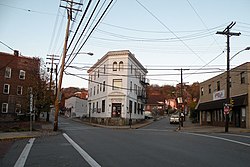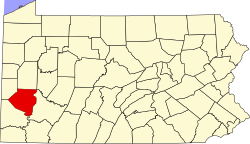History
Prior to European colonial usurpation, the area was inhabited and controlled by the Seneca Indians. It is believed the legendary chief of the Seneca, Cornplanter, called the area Killemun. But even before the Seneca came, the Crafton/Ingram area was inhabited. In her 1993 historical account, local historian and Crafton-native, Betsy Martin, writes that, “Burial mounds from a much earlier pre-Columbian Adena Culture were found farther down the [Chartiers] creek toward the ‘Rocks’ in the vicinity of the Fall Hole.” [4] It is likely Martin is referring to a mound site near the junction of the Creek with the Ohio River, a site which underwent excavations in 1896 by the Carnegie Museum. The excavation unearthed at least 33 burials, all “Early Woodland Adena in affiliation.” [5] The Indians who built the mounds are believed to be Algonquin. While there is no way of knowing exactly which mounds Martin talked about, the reality is that such ancient interment mounds and early-indigenous habitation sites were strewn across the entire Chartiers Valley region, including Crafton/Ingram. Throughout the 20th Century, however, most of the sites were destroyed as a result of industrial development and building construction.
For obvious reasons, the Chartiers Creek was the dominant geographical feature during the premodern era, winding a northwesterly path to its terminus in the Ohio River at McKees Rocks. By 1749/1750, The French, under the aegis of King Louis XV, were staking land claims throughout the creek valley and surrounding forested hills and open meadows. George Washington passed through the area for the first time in 1752, along with his guide, Christopher Gist.
Crafton is named after James S. Craft, a frontier attorney who was granted land near the "forks of the Ohio" in present-day Oakland. [6] The sale of this land part financed purchases of land in the Chartiers valley. Charles Craft, son of James, divided the land into lots on the death of his father and submitted it to the Allegheny County Courthouse as Crafton. After a period of building, the borough was incorporated on January 8, 1892, with Charles as the first burgess. [7] Crafton was linked to downtown Pittsburgh by trolley in 1896. The service ended when the Fort Pitt Bridge was built without trolley tracks.
Demographics
Historical population| Census | Pop. | Note | %± |
|---|
| 1900 | 1,927 | | — |
|---|
| 1910 | 4,583 | | 137.8% |
|---|
| 1920 | 5,954 | | 29.9% |
|---|
| 1930 | 7,004 | | 17.6% |
|---|
| 1940 | 7,163 | | 2.3% |
|---|
| 1950 | 8,066 | | 12.6% |
|---|
| 1960 | 8,418 | | 4.4% |
|---|
| 1970 | 8,233 | | −2.2% |
|---|
| 1980 | 7,623 | | −7.4% |
|---|
| 1990 | 7,188 | | −5.7% |
|---|
| 2000 | 6,706 | | −6.7% |
|---|
| 2010 | 5,951 | | −11.3% |
|---|
| 2020 | 6,099 | | 2.5% |
|---|
|
As of the 2000 census, [13] there were 6,706 people, 3,079 households, and 1,613 families residing in the borough. The population density was 5,916.0 people per square mile (2,284.2 people/km2). There were 3,344 housing units at an average density of 2,950.1 per square mile (1,139.0/km2). The racial makeup of the borough was 95.50% White, 2.74% African American, 0.10% Native American, 0.60% Asian, 0.07% Pacific Islander, 0.15% from other races, and 0.84% from two or more races. Hispanic or Latino of any race were 0.57% of the population.
There were 3,080 households, out of which 24.9% had children under the age of 18 living with them, 38.2% were married couples living together, 10.6% had a female householder with no husband present, and 47.6% were non-families. 40.2% of all households were made up of individuals, and 14.3% had someone living alone who was 65 years of age or older. The average household size was 2.17 and the average family size was 3.01. In the borough the population was spread out, with 21.6% under the age of 18, 8.6% from 18 to 24, 32.5% from 25 to 44, 22.6% from 45 to 64, and 14.8% who were 65 years of age or older. The median age was 38 years. For every 100 females, there were 90.1 males. For every 100 females age 18 and over, there were 86.9 males.
The median income for a household in the borough was $38,323, and the median income for a family was $52,386. Males had a median income of $38,292 versus $24,497 for females. The per capita income for the borough was $21,441. About 3.4% of families and 6.9% of the population were below the poverty line, including 6.5% of those under age 18 and 6.2% of those age 65 or over.
This page is based on this
Wikipedia article Text is available under the
CC BY-SA 4.0 license; additional terms may apply.
Images, videos and audio are available under their respective licenses.









